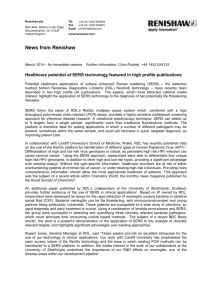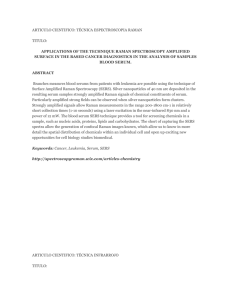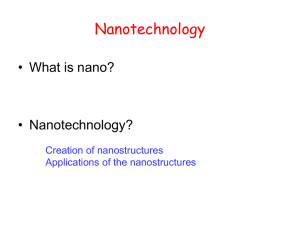Supplementary Information
advertisement
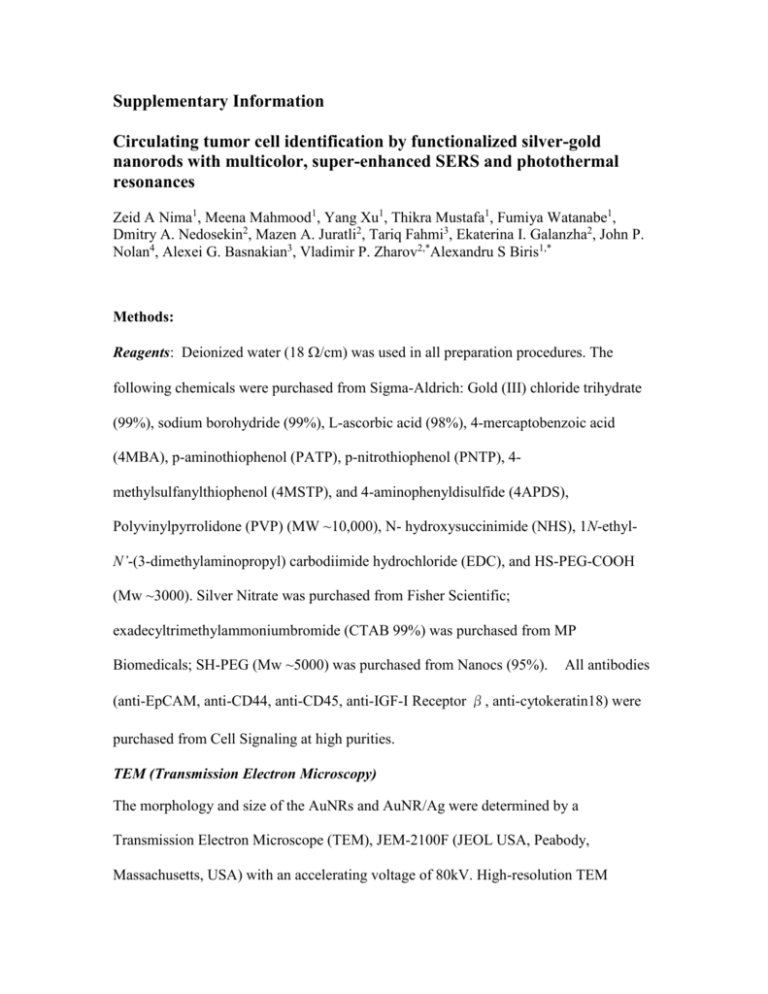
Supplementary Information Circulating tumor cell identification by functionalized silver-gold nanorods with multicolor, super-enhanced SERS and photothermal resonances Zeid A Nima1, Meena Mahmood1, Yang Xu1, Thikra Mustafa1, Fumiya Watanabe1, Dmitry A. Nedosekin2, Mazen A. Juratli2, Tariq Fahmi3, Ekaterina I. Galanzha2, John P. Nolan4, Alexei G. Basnakian3, Vladimir P. Zharov2,*Alexandru S Biris1,* Methods: Reagents: Deionized water (18 /cm) was used in all preparation procedures. The following chemicals were purchased from Sigma-Aldrich: Gold (III) chloride trihydrate (99%), sodium borohydride (99%), L-ascorbic acid (98%), 4-mercaptobenzoic acid (4MBA), p-aminothiophenol (PATP), p-nitrothiophenol (PNTP), 4methylsulfanylthiophenol (4MSTP), and 4-aminophenyldisulfide (4APDS), Polyvinylpyrrolidone (PVP) (MW ~10,000), N- hydroxysuccinimide (NHS), 1N-ethylN’-(3-dimethylaminopropyl) carbodiimide hydrochloride (EDC), and HS-PEG-COOH (Mw ~3000). Silver Nitrate was purchased from Fisher Scientific; exadecyltrimethylammoniumbromide (CTAB 99%) was purchased from MP Biomedicals; SH-PEG (Mw ~5000) was purchased from Nanocs (95%). All antibodies (anti-EpCAM, anti-CD44, anti-CD45, anti-IGF-I Receptor β, anti-cytokeratin18) were purchased from Cell Signaling at high purities. TEM (Transmission Electron Microscopy) The morphology and size of the AuNRs and AuNR/Ag were determined by a Transmission Electron Microscope (TEM), JEM-2100F (JEOL USA, Peabody, Massachusetts, USA) with an accelerating voltage of 80kV. High-resolution TEM (HRTEM) imaging was performed at 200kV. A few drops of each sample, suspended in ethanol, were deposited on holey-carbon coated copper grids, which were allowed to dry for 15 minutes. The average nanorod size and the size distribution of each sample were determined by using ImageJ software (NIH). The PEG-coated AuNR/Ag and the antibody-attached AuNRs/Ag were positively stained with 2% uranyl acetate dissolved in 70% ethanol in order to enhance the contrasts of the antibody coating layer around the AuNR/Ag. TEM was also equipped with an EDAX Genesis energy dispersive spectroscopy (EDS) X-ray detection system. Combined with Scanning Transmission Electron Microscopy (STEM), elemental mappings of AuNRs/Ag were performed with close to 1nm lateral resolution. Annular dark field (ADF) imaging under STEM mode was performed with 1.5nm spot size and 20 cm camera length with a JEOL dark field detector. SEM (Scanning Electron Microscopy) MCF-7 cells were plated and allowed to grow on Thermanox® plastic coverslips (NUNC, Rochester, NY) for 24 hours. SERS nanoagents were added and incubated with the cells for another 30 minutes. Next, MCF-7 cells were fixed primarily with 3% glutaraldehyde in 0.1M phosphate buffer at pH = 7.2, followed by a secondary fixative of 2% OsO4 in 0.1 M phosphate buffer. All of the samples were washed thoroughly with 0.1M phosphate buffer, dehydrated with ascending percentages of ethanol solution, and then dried using Hexamethyldisilazane (HMDS) reagent (EMS, Hatfield, PA). Each dried sample was coated with a thin film of carbon (~ 3nm) and visualized under a SEM, JEOL JSM-7000F (JEOL USA, Peabody, Massachusetts) also equipped with an EDAX EDS system with an accelerating voltage of 15kV and a working distance of ~10 mm. UV-Visible Spectra 100 µg/ml solution of AuNRs, AuNR/Ag, and all SERS nanoagent solutions were measured from 400-900 nm using UV-Visible-NIR spectrophotometer (Shimadzu, UV 3600). Immunohistochemistry Breast adenocarcinoma (MCF-7 cell line) and skin fibroblast (BJ-1 cells) were purchased from American Type Culture Collection (ATCC). Both cell lines were primarily cultured in 75cm2 tissue culture flasks and supplemented with the recommended medium Dulbecco minimum essential medium (DMEM), and Eagle's minimum essential medium (EMEM), respectively, both containing 10% fetal bovine serum (FBS) and 1% penicillin streptomycin (PS). The cells were incubated at 37oC in a humidified incubator and 5% CO2. The medium was changed every 48h with fresh medium until confluent. The two cell lines were co-cultured in two-well chamber slides at a density of 15×104 cells∕well with the percentages of 90% fibroblastic BJ-1 cells and 10% cancerous MCF-7 cells. The mixed cells were then incubated for 24 h for attachment. Post incubation, the cells were washed with 1× of phosphate buffer saline solution 5min each three times. 200 µl of methanol were added to each well and incubated for 20 min at room temperature for fixation. The methanol was removed, and the cells were washed with 1× phosphate buffer saline solution for 5 min each 3 times. Subsequently, 200 µL of blocking buffer containing (1 × PBS∕5% BSA) were added to each well and incubated for 30 min at room temperature. In the interim, a 1:200 dilution of each antibody Anti-EpCam, Anti-CD44, Anti-Keratin 18, and Anti IGF-I was prepared using blocking buffer in separate labeled tubes. The blocking buffer was removed, and the diluted antibodies were added to each well and incubated over night at 4˚C. The cells were then washed with 1× of phosphate buffer saline solution for for 5 min each 3 times. Four secondary polyclonal antibodies (goat to mouse IgG) with different fluorescent tags--Alexa Flour 488, 555, 594, and 647 (abcam, Cambridge, MA)--were diluted in a ratio of 1:500 with blocking buffer. The secondary antibodies were added to each well and incubated for 1 h in the dark at room temperature. The cells were washed with 1× phosphate buffer saline solution for 5 min each 3 times and then 200 µL of 0.5% µg∕ml of 4',6-diamidino-2-phenylindole (DAPI) were added and incubated for 5 min at room temperature in the dark to perform nuclear staining. The cells were mounted with mounting medium, covered with the cover slips, and the edges were sealed. Finally, the cells were kept in the dark at 4˚C until examination under the fluorescence microscope using an Olympus BX 51 microscope. Silver-coated Gold nanorods (AuNR/Ag) fabrication and properties AuNRs have optoelectronic properties characterized by two separate localized Surface Plasmon Resonance (LSPR) profiles: low energy at around 520 nm and high energy ranging from 700 nm to NIR depending on the aspect ratio (diameter, length/width). These two plasmons are the result of induced oscillations on the metallic surface that strongly disturb the near field resonance, producing intensive light absorption and scattering1,2. The importance of the second plasmon, longitudinal mode, for SERS applications is that it can be tuned to specific spectral energies by accurately controlling the aspect ratio of the nanorods 3-4 or through the use of surface coatings as needed. This facility is not easily obtained with other shapes, such as spherical structures5. Recently, silver nanoparticles have been widely used for biosensors or bio-probes because they are more stable and resistant to oxidation compared with gold 6. A comparison of the absorption variation as a function of electronic temperature indicated stronger absorption capabilities for Ag (390 nm) compared with Au (530 nm) nanoparticles of identical sizes7. Additionally, silver-coated nanorods were shown to have broader scattering spectra compared to the simple Au-only NRs, indicating extremely interesting optoelectronic properties induced by the Au-Ag interface8, which makes such bi-metal nanorods excellent candidates to serve as complex agents for spectroscopic tumor detection. Many biocompatible nanomaterials with unique optical properties have been developed for immunoassays, biochemical sensing, imaging, and treatment of cancer 9 . Several optical methods such as fluorescence, surface enhanced Raman spectroscopy (SERS), and photothermal spectroscopy demonstrated real potential to achieve ultimate sensitivity limit at the level of single nanoparticle and molecule10-11 . However, the most optical methods still suffer from relatively low specificity and signal intensity in complex biological backgrounds due to the use of just one or two diseaseassociated markers, their unpredictable expression, nonspecific nanoparticle binding, and label color overlapping 12-14. It is well known that thiolated molecules (-S-R) are more easily assembled onto silver surfaces than onto gold15 due to the formation of Ag-S-R covalent bonds. These small thiolated organic molecules absorbed on the surface of the AuNR/Ag are responsible for the Raman signature of the spectroscopic nano-agents. To stabilize the four classes of SERS nanoagents and serve as a linker for the layer of antibodies, a HSPEG(5kDa)/HS-PEG-COOH(3kDa) mixture was used. Calculations indicated that the spectroscopic nano-agents would require approximately 4,200 molecules to assure complete surface coverage, i.e., each HS-PEG molecule required a 0.35nm2 footprint16. HS-PEG molecules protect the nanorods’ surface and make the SERS nanoagents more hydrophilic and easily dispersible in an aqueous medium, such as biological fluids. Additionally, the SH-PEG-COOH groups provide the required carboxylic terminal, which is used as the linker between the nanorod surface and the antibodies needed for targeting the cancer cells. Thiolated PEG polymers are widely used with SERS tags and are well known to be relatively non-toxic; additionally, they do not displace Raman reporter molecules attached to the surfaces of AuNR/Ag17. Specificity of Antibody-Bound SERS agents To ensure that SERS agents specifically recognize their homologous antigens, the protein array assay was performed using the SuperEpoxy 3 substrate slides (Arrayit, Sunnyvale, CA). Recombinant human antigen proteins including EpCAM, CD44, keratin 18 (all from OriGene, Rockville, MD), and IGF-1β (Abcam, Cambridge, MA) were bound to glass slides overnight, which were then treated with the Protein Microarray Activation Buffer (Cat. PMAB, Arrayit, Sunnyvale, CA) and rinsed as suggested by the manufacturer to unbound protein molecules from the surface and to shield the surface against non-specific binding. The slides were then exposed with the SERS agents for 60 min as shown in the scheme in Figure S9A, washed and rinsed again, and the signals were measured using Raman spectroscopy for each of the antibody/antigen combinations. The results of this test clearly showed that the SERS agents were highly specific to their homologous antigens and gave no Raman signal when tested against three other (heterologous) antigens (Figure S9B). Cytotoxicity of SERS nanorods. Some nanoparticles are cytotoxic, and are able to induce apoptosis during exposure with cells. To assess apoptosis induction in MCF-7 cells by SERS agents, Annexin V (FITC)/ propidium iodide (PI) assay was used as described previously (Yin X et al, J Am Soc Nephrol 18, 9, 2544-2553). Briefly, 500,000 cells were exposed with 0100 µg/mL SERS agents for 30 min at 37 oC, then trypsinized, resuspended, stained with the dyes, and subjected to flow cytometric analysis in a FACS Calibur flow cytometer (Becton Dickinson). Cell Quest software was used to analyze the data collected. Each sample had three independent measurements. This experiment demonstrated the absence of apoptosis above control level in MCF-7 cells after 30 min exposure with SERS agents at all used concentrations up to 100 µg/ml (Figure S17A). However, MCF-7 and other cancer cells are notoriously resistant to cell death inducers because they lack activities of executioner apoptotic enzymes, such as caspases and endonucleases. In particular, MCF7 cells do not express caspase-3 18. To overcome this and to measure potential (maximal) toxicity of the nanorods, we next used normal rat kidney NRK-52E cells, which express caspase-3 19 and most active apoptotic endonucleases, DNase I and EndoG20. We also used highly sensitive TUNEL assay to measure irreversible cell death of all kinds, as opposed to apoptosis only. The TUNEL assay was performed as described earlier21. In addition, the cells were exposed with the nanorods at 50 µg/ml for 24 hours, which is much longer than the time used in the experiments. This test showed statistically significant cell death, which still did not exceed 3% of total cells or 1.5% above the untreated control (Figure S17B). Taken together, these data suggest that the SERS agents have very low toxicity, which is likely to have no effect during the used 30-min exposure time with the cells. XPS analysis of Ag shells on functionalized nanorods. To assess the oxidation states of Ag-covered Au nanrods, X-ray photoelectron spectroscopy (XPS) analysis was carried out using a Thermo Scientific Model K-Alpha XPS system equipped with a 36W monochromatic Al K (1486.7 eV) X-ray source. Although a flood gun was used during the spectral collection, all spectra were chargecorrected using the C 1s peak (C1s is the most dominant peak in our signal and amounted to ~80%), due to adventitious hydrocarbon, set to 285.0 eV. The ethanol containing the functionalized nanorods was dripped onto double- sided tape attached to an aluminum plate that was dried for an hour before being inserted into our XPS system. XPS analysis has a typical sampling depth of 3-3.5 nm for metals, which is defined as three times the mean free path of electrons at a given energy. The gold nanorod core is ~36 nm long and ~12 nm in diameter. The Ag shell is 2 nm thick, and its surface is functionalized and covered by PEG and biological molecules. (See TEM images in Fig. 2 of the manuscript.) The thickness of the functionalizing organic layer is approximately 1nm. The volumes occupied by Au and Ag in our typical nanorod are close to a 1:1 ratio; however, the reported elemental ratio for Ag to Au by this XPS study is approximately 5:2 because the sampling depth of XPS is only slightly larger than the Ag shell thickness. (The total Ag (Au) content measured on our functionalized nanorod sample was ~0.43% (0.17%) due to the minute amount of the nanorods compared to the background signals from the double-sided tape used to fix the nanorods.). The binding energy of Ag3d5/2 is most commonly used to determine the existence of Ag. However, with respect to the oxidation state of the silver shells, as we point out, silver is an element that is rather difficult to assess from its XPS peaks due to very small chemical shifts. For the Ag(0) metallic state, the binding energy of Ag3d5/2 is at 368.2±0.1eV. The binding energy of Ag2O 3d5/2 is reported to have a -0.3eV (negative) shift, while the other oxide, AgO, shifts by -0.8eV (also a negative shift). To help determine the chemical state of our 2 nm thick Ag shells on the functionalized nanorods, we have measured the following: 1) the Ag3d XPS spectra, 2) the MNN Auger transition spectra of Ag, 3) the O1s XPS spectra, and 4) the S2p XPS spectra. We have also collected spectra for C1s, Au4f, and N1s (plots not shown for these elements). In Fig. 19 (a), our XPS results show that the Ag3d5/2 peak has components at 368.30 eV and 369.78 eV. (In this report, we concentrate on the Ag3d5/2 binding energies, not on the Ag3d3/2). The component of the peak at 369.78 eV may be attributed to the “charge transfer states” discussed in some reports1. Positive core level shifts for Ag3d5/2 have also been reported for extremely small Ag nanoparticles approaching 2nm in diameter2. Nevertheless, the peaks of these “charge transfer states” amount to less than 10% of the main peak area of the Ag3d5/2 component (at 368.30eV). The obtained binding energy of 368.30 eV falls within the accepted range for the pure metallic state value of 368.2±0.1 eV and close to the Ag2S state value at 368.1 eV. The commonly reported values for Ag2O and AgO have negative shifts and are at 367.9 eV and 367.6 eV, respectively. Thus, we concluded that the Ag shells on the nanorods were primarily metallic Ag(0) and/or AgS. Since XPS analysis of Ag 3d5/2 poses difficulties in determining the oxidation states of Ag, Auger electron analysis has been suggested for better results in the chemical state determination of Ag.22, 23 We have measured the Ag MNN Auger spectrum for our sample, and the result is given in Fig. S19(b). The Auger MNN peaks were centered at 357.5 eV and 351.4 eV. The Auger parameter24 for the first peak was calculated to be 725.8 eV, which again falls between the reported values for metallic Ag (726.1 eV) and Ag2S (724.8 eV), but is closer to the value for metallic Ag. The reported Auger parameters for Ag2O and AgO states are 724.4 eV and 724.5eV. In addition, the Auger peaks for pure metallic Ag are said to have sharper peak shapes (lower FWHM values), while our Auger peaks exhibit wider, non-metallic state shapes.22 However, our peak shape does not exclude the fact that the signal is from a mixture of Ag metallic and Ag2S states. The sampling depth of Auger electron spectroscopy for Ag is ~2-2.5nm and is less than that of XPS (3-3.5nm) using Al K radiation. With a few nanometers of functionalizing molecules, we are most likely probing Ag shells of the nanorods only (no Au). In fact, no Au Auger transitions were detected in our sample. Based on the Auger parameter value and the peak shapes, as well as the XPS results above, we believe that our Ag shell surfaces on the nanorods are covered by sulfides, such as Ag2S, while the majority of the Ag shell remains metallic. (This is not surprising since the molecules we used to functionalize our nanorods have S atoms as binding agents.) In Fig. S19(c), the O1s peak from this sample is given. Only two components at 532.26 eV and 533.59 eV are needed to fit this O1s peak from our nanorod sample. These can be assigned to organics such as C-O-C/sulfates and adsorbed oxygen/organics, respectively, but not to Ag2O (528.5~529.3eV) or AgO (529.2~530.9 V).25 Despite the minute amount of Ag (~04%) vs. the oxygen (~20%), we concluded from this spectrum that only a few of the Ag shells of our nanorods were oxidized, if any. Finally, in Fig. S19(d), S2p peaks are shown with the components at 162.82 eV and 168.52 eV. The binding energy of Ag2S is reported to be ~161.0 eV and sulfates at 168.4 eV. (This sulfate peak was most likely the result of a background signal related to the double-sided tape). S-S bonds also have an S2p peak at 163.0eV. In recent years, numerous reports of Ag nanoparticles encapsulated in S-containing molecules having S2p peaks at around 163 eV have been published.26, 27, 28 The existence of S-S states are more likely given that the quantitative analysis of the S2p peak at 162.82 eV and the Ag 3d5/2 peak at 368.30eV both yield an atomic concentration of ~0.22%, making the S to Ag stoichiometric ratio 1:1 within the XPS depth information of ~7.5 nm. We do not believe our Ag shells to be completely AgS on our nanorods. Instead, we have S-S complex and Ag2S near the surfaces of our nanorod shells. Our XPS/Auger analysis strongly suggests that our nanorods’ surfaces are completely covered by stable functionalized molecules with sulfur as the binding agent and almost no oxygen bonded to Ag atoms on the shells. In addition to the timedependent intensity variation of SERS signals, this evidence suggests that our nanorods are fairly stable, at least for the duration of our experiments, and that the oxidation of their surfaces is minimal and insignificant. Antibody HS-PEG-COOH Raman Molecule Silver Layer Gold Core Figure (S1): Layer-by-layer SERS nanoagent assembly. Figure (S2): TEM images of AuNRs with different magnifications: x100k, x300k, x600k Figure (S3): STEM Images of AuNR/Ag with the 1.70±0.30 nm thickness of Ag. Figure (S4): TEM images of AuNR/Ag functionalized by HS-PEG/HS-PEGCOOH/anti-IGF. Figure (S5): Optical absorption spectra for AuNR/Ag SERS nanoagents after functionalization with the five markers. Figure (S6): Raman spectrum of AuNRs with Black Hole Quencher-3 amine (BHQ). Nanoparticles with Raman active molecules/Raman data/TEM image were provided by Dr. John P. Nolan from La Jolla Bioengineering Institute, California29. The inset represents the TEM images of gold nanorods (AuNRs) with longitudinal resonance at wavelength of 625 nm. Figure (S7). Linear PT spectroscopy of clustered nanoparticles. Laser fluence in the range from 10 to 100 mJ/cm2. Transmission microscopy (right) was used to calculate cluster size. Figure (S8): Flow Cytometry analysis of the specificity of the four antibodies for MCF7 cancer cell targeting. Figure (S9): Antigen-binding specificity of AuNR/Ag. Antigen-binding specificity was determined using protein array. The scheme of the experiment is presented in upper panel (A); the Raman spectra are shown in lower panels (B). Figure (S10): SEM images of MCF7 only and MCF7 incubated with SERS nanoagents for 30min. Figure (S11): TEM images of MCF7 incubated with SERS nanoagents for 30 minutes. Figure (S12): SERS mapping images of a single MCF7 cell among fibroblasts. Figure (S13): SERS mapping images of MCF7 cells among around 7x106 of white blood cells. Figure (S14): SERS mapping images of MCF7 cells among 7x106 whole blood cells. Figure (S15): SERS mapping images of white blood cells only. Figure (S16): Selective SERS nanorods labeling of anti-CD45 expressing WBCs visualized by (a1) Transmission, (a2) Raman and (a3) merged images of a MCF7 cell among anti-CD45 labeled WBCs in separated blood sample. (b1) Transmission,(b2) EDFM, and (b3) PT microscopy images for similar areas of the same sample. PT microscopy parameters: excitation wavelength of 532 nm; laser pulse energy of 100 pJ; averaging of PT 10 signals per pixel; scanning stage step of 250 nm. Figure (S17): Cytotoxicity of AuNR/Ag. (A) Apoptosis was measured using Annexin V flow cytometry after exposure of AuNR/Ag at varying concentrations with human breast cancer MCF-7 cells for 30 min (n=3). (B) TUNEL assay was assessed in NRK-52E kidney tubular epithelial cells exposed with AuNR/Ag (50 μg/ml) for 24 hours (n=4). Figure (S18): SERS and PT (insert) signal intensity changes as the function of AuNR/Ag cluster sizes. In the SERS experiment, the sample of the SERS agent was placed on a glass slide and kept 3 days to dry, then several spots of different cluster sizes (~1-15 μm) were scanned with a Raman spectrometer using laser 784nm (1.02 mW) The acquisition time was 10s. Figure S19: XPS (a) Ag3d peaks with components. Ag 3d5/2 is fitted with a peak at 368.30 eV (Metallic Ag at 368.2 eV or Ag2S at 368.1 eV) and another at 369.78 eV (charge transfer state). The area ratios of these two components are 1.0:0.13. The green line represents the background. Ag 3d3/2 was fitted in a similar manner with one main peak and a charge transfer state. (b) Auger MNN transition peaks for Ag. Peaks are centered at 357.5 eV and 351.4 eV. (c) The O1s peak fitted with a component at 532.22 eV (possibly sulfate) and another at 533.52 eV (adsorbed water and organics) shows no peak corresponding to Ag2O (529.20~530.90eV) or AgO (529.20~530.90eV). (d) The S2p peak fitted with a component at 162.82eV and another at 168.52 eV. No Ag2S (161.0 eV) or AgS (160.8 eV) was detected. Figure (S20): Stability of nanoagents’ SERS signal as a function of the analysis time period. For about 16 days and several laser exposures, the nanorods were found to remain stable and generate relatively constant intensity of Raman signals. The nanorods solution was allowed to dry into small clusters for 3 days before the measurements were performed. References 1. 2. 3. 4. 5. 6. 7. 8. 9. 10. 11. 12. 13. 14. 15. Huang, X., Jain, P.K., El-Sayed, I.H. & El-Sayed, M.A. Gold nanoparticles: interesting optical properties and recent applications in cancer diagnostics and therapy. Nanomedicine (Lond) 2, 681-693 (2007). Link, S. & El-Sayed, M.A. Spectral properties and relaxation dynamics of surface plasmon electronic oscillations in gold and silver nanodots and nanorods. The Journal of Physical Chemistry B 103, 8410-8426 (1999). Nikoobakht, B. & El-Sayed, M.A. Preparation and growth mechanism of gold nanorods (NRs) using seed-mediated growth method. Chem. Mater. 15, 19571962 (2003). Mohamed, M.B., Ismail, K.Z., Link, S. & El-Sayed, M.A. Thermal reshaping of gold nanorods in micelles. The Journal of Physical Chemistry B 102, 93709374 (1998). Kim, K., Kim, K.L. & Lee, S.J. Surface enrichment of Ag atoms in Au/Ag alloy nanoparticles revealed by surface enhanced Raman scattering spectroscopy. Chemical Physics Letters 403, 77-82 (2005). Tsung, C.-K. et al. Selective shortening of single-crystalline gold nanorods by mild oxidation. Journal of the American Chemical Society 128, 5352-5353 (2006). Hodak, J.H., Martini, I. & Hartland, G.V. Spectroscopy and dynamics of nanometer-sized noble metal particles. The Journal of Physical Chemistry B 102, 6958-6967 (1998). Liu, M. & Guyot-Sionnest, P. Synthesis and optical characterization of Au/Ag core/shell nanorods. J. Phys. Chem. B 108, 5882-5888 (2004). Yu, M. et al. Circulating breast tumor cells exhibit dynamic changes in epithelial and mesenchymal composition. Science 339, 580-584 (2013). Stott, S.L. et al. Isolation of circulating tumor cells using a microvortexgenerating herringbone-chip. PNAS 107, 18392-18397 (2010). Gao, X., Cui, Y., Levenson, R.M., Chung, L.W.K. & Nie, S. In vivo cancer targeting and imaging with semiconductor quantum dots. Nat Biotech 22, 969-976 (2004). Anker, J.N. et al. Biosensing with plasmonic nanosensors. Nat Mater 7, 442453 (2008). Gaiduk, A., Yorulmaz, M., Ruijgrok, P.V. & Orrit, M. Room-temperature detection of a single molecule’s absorption by photothermal contrast. Science 330, 353-356 (2010). Cognet, L., Berciaud, S., Lasne, D. & Lounis, B. Photothermal methods for single nonluminescent nano-objects. Analytical Chemistry 80, 2288-2294 (2008). Zong, S. et al. A SERS and fluorescence dual mode cancer cell targeting probe based on silica coated Au@Ag core-shell nanorods. Talanta 97, 368-375 (2012). 16. 17. 18. 19. 20. 21. 22. 23. 24. 25. 26. 27. 28. 29. Qian, X. et al. In vivo tumor targeting and spectroscopic detection with surface-enhanced Raman nanoparticle tags. Nat Biotech 26, 83-90 (2008). Jiang, J.D., Burstein, E. & Kobayashi, H. Resonant Raman scattering by crystalviolet molecules adsorbed on a smooth gold surface: Evidence for a chargetransfer excitation. Phys Rev Lett 57, 1793-1796 (1986). Jänicke, R. MCF-7 breast carcinoma cells do not express caspase-3. Breast Cancer Research and Treatment 117, 219-221 (2009). Hsu, Y.H. et al. Prostacyclin protects renal tubular cells from gentamicininduced apoptosis via a PPAR[alpha]-dependent pathway. Kidney Int\ 73\, 578\-587\ (2007). Yin, X. et al. Induction of renal endonuclease G by cisplatin is reduced in DNase I-deficient mice. Journal of the American Society of Nephrology 18, 2544-2553 (2007). Singh, M. et al. Protective effect of zinc-N-acetylcysteine on the rat kidney during cold storage. American Journal of Physiology - Renal Physiology 305, F1022-F1030 (2013). Ferraria, A.M., Carapeto, A.P. & Botelho do Rego, A.M. X-ray photoelectron spectroscopy: Silver salts revisited. Vacuum 86, 1988-1991 (2012). Lopez-Salido, I., Lim, D.C. & Kim, Y.D. Ag nanoparticles on highly ordered pyrolytic graphite (HOPG) surfaces studied using STM and XPS. Surface Science 588, 6-18 (2005). Wagner, D., Naumkin, A.V., Kraut-Vass, A. , Allison, J.W. , Powell, C.J., Rumble, J.R.Jr. NIST standard reference database Vol. 20. (2003). Beamson, G., Briggs, D. High resolution XPS of organic polymers - The scienta ESCA300 database, Vol. Appendices 3.1 and 3.2. (Wiley Interscience, 1992). Zou, X. et al. Mercaptoethane sulfonate protected, water-soluble gold and silver nanoparticles: Syntheses, characterization and their building multilayer films with polyaniline via ion–dipole interactions. Journal of Colloid and Interface Science 295, 401-408 (2006). Tan, Y., Wang, Y., Jiang, L. & Zhu, D. Thiosalicylic acid-functionalized silver nanoparticles synthesized in one-phase system. Journal of Colloid and Interface Science 249, 336-345 (2002). Lee, E., Piao, L. & Kim, J. Synthesis of silver nanoparticles from the decomposition of silver (I)[bis (alkylthio) methylene] malonate complexes. Bulletin of Korean Chemical Society 33, 60-64 (2012). Nolan, J.P. et al. Single cell analysis using surface enhanced Raman scattering (SERS) tags. Methods 57, 272-279 (2012).
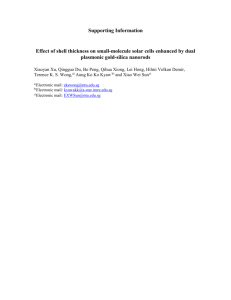
![[1] M. Fleischmann, P.J. Hendra, A.J. McQuillan, Chem. Phy. Lett. 26](http://s3.studylib.net/store/data/005884231_1-c0a3447ecba2eee2a6ded029e33997e8-300x300.png)
